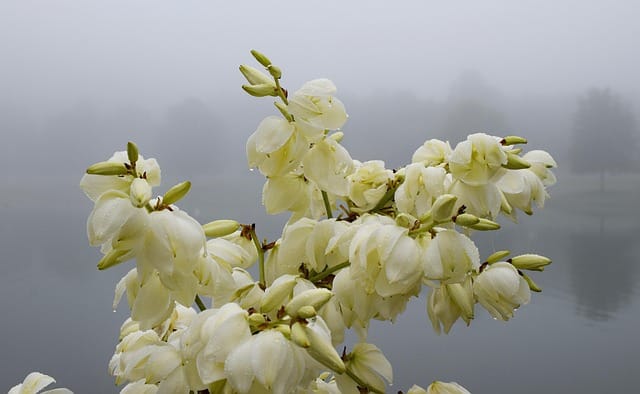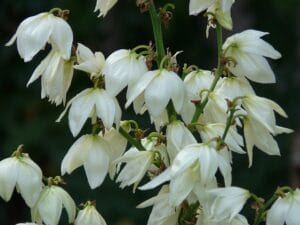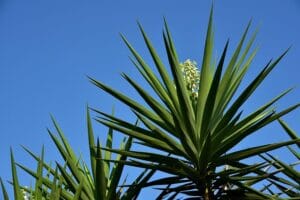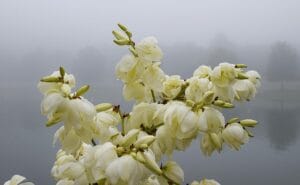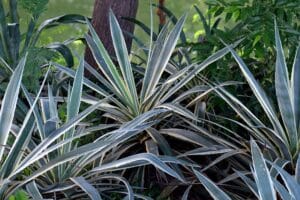How to Grow and Care for a Yucca Plant at Home
Introduction
Yucca plants are beloved for their bold, sword-like leaves and low-maintenance nature. Perfect for both indoor containers and outdoor landscapes, they bring a touch of the desert into your home. Native to the arid regions of North and Central America, Yuccas are drought-tolerant and thrive on neglect—making them ideal for busy or beginner plant lovers.
Whether you’re decorating your living room or designing a xeriscape garden, learning how to grow and care for a Yucca plant properly can ensure long-lasting beauty.
| Feature | Details |
| Common Name | Yucca Plant |
| Botanical Name | Yucca spp. |
| Light Requirement | Bright, indirect sunlight |
| Watering | Low; water when topsoil is dry |
| Soil Type | Well-draining, sandy or gritty soil |
| Ideal Temperature | 60°F–80°F (15°C–27°C) |
| Toxicity | Mildly toxic to pets (especially dogs & cats) |
| Hardiness Zone | USDA 4–11 (varies by species) |
What is a Yucca Plant
A Yucca plant is a hardy, drought-tolerant perennial native to arid regions of North and Central America. Known for its striking, sword-shaped leaves and tall flower spikes, the Yucca belongs to the Asparagaceae family. It thrives in dry, well-drained soil and requires minimal care, making it popular for both indoor and outdoor gardening. Yuccas can be ornamental or functional, often used in xeriscaping due to their resilience to heat and low water needs. Some species bloom with clusters of white, bell-shaped flowers. With their bold structure and easy maintenance, Yuccas are ideal for those seeking a low-maintenance, sculptural plant.
What does a yucca plant look like
A Yucca plant has a striking, architectural appearance with long, sword-shaped leaves that grow in a rosette pattern. The leaves are often stiff, pointed, and can be green, blue-green, or even variegated. Some species develop a thick, woody trunk, giving them a tree-like form. Mature Yuccas may produce tall flower stalks with clusters of white, bell-shaped blooms, adding to their bold, desert-inspired look.
Choosing the Right Location
Indoor Yucca:
- Place near a south- or west-facing window with lots of bright, indirect light.
- Avoid direct harsh sun indoors to prevent leaf burn.
Outdoor Yucca:
- Select a sunny, dry, and well-drained spot.
- Perfect for rock gardens, desert landscaping, and container patios.
Avoid dark corners or waterlogged areas. Yuccas hate “wet feet.”
Types of Yucca Plants
Here are some popular Yucca varieties for home growers:
| Species | Ideal For | Notes |
| Yucca elephantipes | Indoors | Spineless leaves, attractive trunk |
| Yucca filamentosa | Outdoors | Hardy in cold zones, spiky leaves |
| Yucca gloriosa | Landscape | Bright green sword-shaped leaves |
| Yucca rostrata | Decorative Gardens | Blue-green foliage, dramatic appearance |
How to Plant a Yucca Plant
Potting Yucca (Indoor):
Potting a Yucca plant requires a well-draining container with drainage holes to prevent root rot. Use a cactus or succulent soil mix, or combine sand, perlite, and compost. Choose a sturdy pot, as Yucca can become top-heavy. Position the plant upright, fill the surrounding area around the roots, and water lightly. Keep it in a bright, sunny location indoors.
Planting in Garden (Outdoor):
To plant Yucca in your garden, choose a sunny, well-draining spot. Dig a hole twice the size of the root ball and loosen the soil. Gently place the plant, backfill with sandy soil, and water lightly. Ensure proper spacing between multiple plants to allow air circulation and growth. Avoid planting in areas with poor drainage to prevent root rot.
Watering Requirements
Yucca plants prefer dry conditions and are highly drought-tolerant. Allow the soil to dry out completely between waterings. For indoor plants, water every 2–3 weeks, depending on temperature and humidity. Outdoor Yuccas need watering only during extended dry spells. Always ensure the pot or soil has good drainage to prevent root rot. Overwatering is one of the most common mistakes with Yuccas, so it’s better to underwater than overwater. Reduce watering frequency during winter when the plant is dormant.
- Overwatering causes root rot, a common killer of Yucca.
Temperature and Humidity
Yucca plants thrive in warm, dry environments. They prefer temperatures between 60°F to 80°F (15°C to 27°C) and can tolerate occasional dips but not freezing conditions. Avoid exposing them to cold drafts or sudden temperature changes. Humidity should remain low to moderate, making them ideal for typical indoor settings. High humidity or excess moisture can lead to fungal issues, so always ensure good air circulation and avoid misting the leaves.
Fertilizing Yucca Plants
Yucca plants require minimal fertilization, but occasional feeding boosts their growth. Use a balanced, water-soluble fertilizer (10-10-10) during the active growing season—spring through summer. Apply every 6–8 weeks, but avoid over-fertilizing as it can damage the roots or cause leaf tip burn. Refrain from feeding during winter dormancy. For best results, water the plant before applying fertilizer to prevent root stress.
Pruning and Maintenance
Pruning a Yucca plant helps maintain its shape, remove dead or damaged leaves, and promote healthy growth. Use clean, sharp shears to trim yellowing or dry leaves near the base. For outdoor Yuccas, you can cut older stems to rejuvenate the plant. Prune flower stalks after blooming to keep the plant tidy. Minimal maintenance is needed overall, but regular inspection for pests and dead foliage ensures your Yucca remains vibrant, structured, and healthy throughout the year.
Flowering
Yucca plants produce striking, tall flower stalks topped with clusters of white or cream-colored bell-shaped flowers. Flowering typically occurs in the late spring to summer, especially in mature outdoor plants that receive ample sunlight. Indoor Yuccas rarely bloom due to limited light exposure. The flowers are not only visually stunning but also attract pollinators like bees and moths. After flowering, it’s best to trim the stalk to maintain the plant’s shape and encourage healthy future growth.
Propagation Methods
Yucca plants can be easily propagated through offsets (pups), stem cuttings, and division. Offsets are small shoots that grow near the plant’s base; they can be removed and replanted after drying for a day. Stem cuttings involve trimming a healthy stem, letting it callous, and planting it in sandy soil. Division is useful for large clumping Yuccas, where the root ball is split into sections. Each method offers a simple way to grow new plants from your existing Yucca.
Common Problems & Solutions
| Problem | Cause | Solution |
| Yellow leaves | Overwatering | Water less, check soil drainage |
| Brown leaf tips | Low humidity or salt buildup | Use distilled water, avoid misting |
| Droopy leaves | Lack of light | Move to brighter location |
| Root rot | Poor drainage | Repot in dry soil, remove rotted parts |
| Pest infestation (spider mites, mealybugs) | Dry air or poor airflow | Use neem oil or insecticidal soap |
Yucca plant outdoor
The outdoor Yucca plant thrives in sunny, dry environments and adds a bold, architectural touch to landscapes. Known for its sword-shaped leaves and tall flower spikes, it is ideal for xeriscaping, rock gardens, and drought-prone areas. Yuccas prefer well-draining soil and minimal watering, making them low-maintenance. Hardy and resilient, they can tolerate heat, poor soil, and even frost, depending on the variety. Perfect for creating a desert-inspired outdoor space.
Is Yucca Plant Toxic to Pets?
Yes, Yucca plants contain saponins, which are mildly toxic to cats and dogs if ingested.
Symptoms in pets:
- Vomiting
- Drooling
- Weakness
Keep Yucca out of reach of curious pets.
Yucca Plant Care
Yucca plant care is simple, making it ideal for beginners. Place your yucca in a bright spot with plenty of indirect sunlight. Use well-draining soil—preferably sandy or gritty—to prevent root rot. Water sparingly, allowing the top 2–3 inches of soil to dry between watering. Avoid overwatering, especially in winter. Yuccas prefer warm temperatures and low humidity. Prune dead or yellowing leaves to maintain its shape. Fertilize sparingly during spring and summer with a balanced liquid fertilizer. Keep the plant away from pets, as it can be mildly toxic. With minimal attention, yucca thrives indoors and outdoors beautifully.
Benefits of Yucca Plant
- Air purifying – Removes toxins like benzene and formaldehyde.
- Drought-tolerant – Requires minimal watering.
- Architectural beauty – Adds structure and height to any room.
- Medicinal uses (in traditional systems) – Some parts used for skin and joint issues.
- Low maintenance – Great for beginners.
Red Yucca Plant
Red Yucca Plant (Hesperaloe parviflora) is a stunning, drought-tolerant perennial native to Texas and northern Mexico. Despite its name, it’s not a true yucca but closely resembles one with its long, arching, evergreen leaves. In late spring through summer, it produces tall flower spikes with vibrant red to coral tubular blooms that attract hummingbirds and pollinators. Ideal for xeriscaping, this plant thrives in full sun and well-drained soil. Red Yucca is incredibly low-maintenance, heat-tolerant, and deer-resistant, making it a favorite for desert and rock gardens. It also works beautifully in pots and borders for a striking, architectural accent.
Container Gardening Tips
- Choose terracotta pots for better breathability.
- Repot every 2–3 years or when rootbound.
- Clean leaves occasionally with a dry cloth.
Frequently Asked Questions (FAQs)
Q1. How fast does Yucca grow?
A: Yuccas grow slowly, typically a few inches per year. Outdoor plants may grow faster.
Q2. Can I grow Yucca from seeds?
A: Yes, but it’s slow. Seeds may take weeks to germinate.
Q3. How often should I repot my indoor Yucca?
A: Every 2–3 years or when roots start poking out of the drainage holes.
Q4. Should I mist my Yucca plant?
A: No. Yucca prefers dry air; misting may encourage fungal growth.
Q5. Does Yucca bloom indoors?
A: Rarely. It needs high light and maturity to flower indoors.
Conclusion
Yucca plants are a fantastic choice for anyone seeking a low-maintenance, strikingly architectural, and long-living houseplant. With proper sunlight, dry soil, and occasional care, your Yucca can thrive for years—both indoors and outdoors.
Whether you’re a novice gardener or seasoned plant parent, growing Yucca at home is simple, rewarding, and aesthetically pleasing. Just remember.

